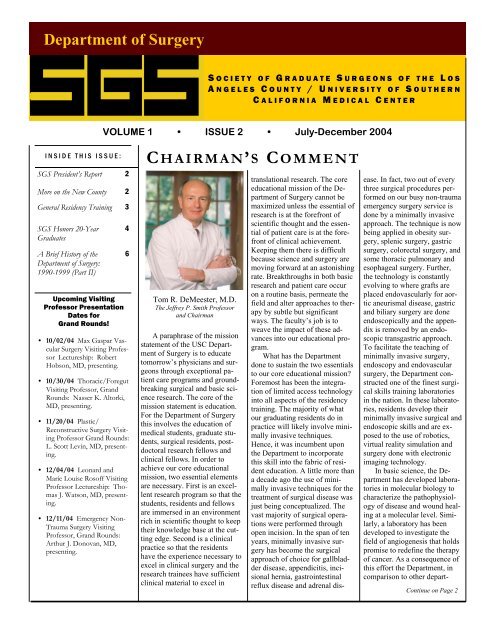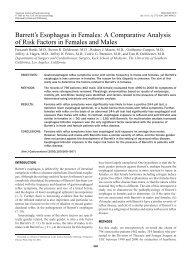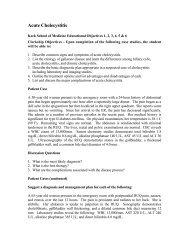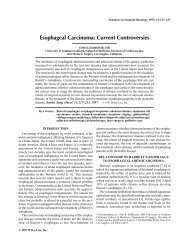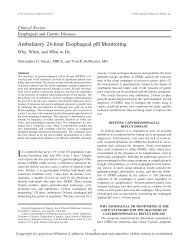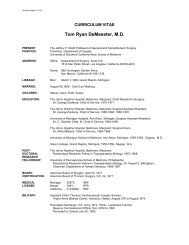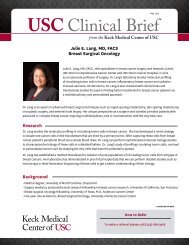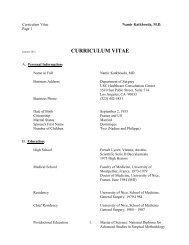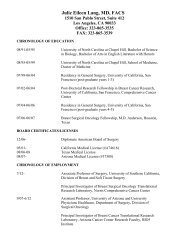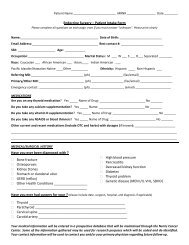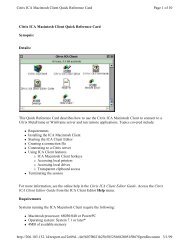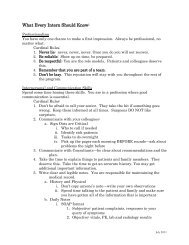SGS Honors 20-Year Graduates - USC Department of Surgery ...
SGS Honors 20-Year Graduates - USC Department of Surgery ...
SGS Honors 20-Year Graduates - USC Department of Surgery ...
Create successful ePaper yourself
Turn your PDF publications into a flip-book with our unique Google optimized e-Paper software.
<strong>Department</strong> <strong>of</strong> <strong>Surgery</strong><br />
S OCIETY OF GRADUATE SURGEONS OF THE LOS<br />
A NGELES COUNTY / UNIVERSITY OF SOUTHERN<br />
C ALIFORNIA MEDICAL CENTER<br />
VOLUME 1 • ISSUE 2 • July-December <strong>20</strong>04<br />
INSIDE THIS ISSUE:<br />
<strong>SGS</strong> President’s Report 2<br />
More on the New County 2<br />
General Residency Training 3<br />
<strong>SGS</strong> <strong>Honors</strong> <strong>20</strong>-<strong>Year</strong><br />
<strong>Graduates</strong><br />
A Brief History <strong>of</strong> the<br />
<strong>Department</strong> <strong>of</strong> <strong>Surgery</strong>:<br />
1990-1999 (Part II)<br />
Upcoming Visiting<br />
Pr<strong>of</strong>essor Presentation<br />
Dates for<br />
Grand Rounds!<br />
• 10/02/04 Max Gaspar Vascular<br />
<strong>Surgery</strong> Visiting Pr<strong>of</strong>essor<br />
Lectureship: Robert<br />
Hobson, MD, presenting.<br />
• 10/30/04 Thoracic/Foregut<br />
Visiting Pr<strong>of</strong>essor, Grand<br />
Rounds: Nasser K. Altorki,<br />
MD, presenting.<br />
• 11/<strong>20</strong>/04 Plastic/<br />
Reconstructive <strong>Surgery</strong> Visiting<br />
Pr<strong>of</strong>essor Grand Rounds:<br />
L. Scott Levin, MD, presenting.<br />
• 12/04/04 Leonard and<br />
Marie Louise Ros<strong>of</strong>f Visiting<br />
Pr<strong>of</strong>essor Lectureship: Thomas<br />
J. Watson, MD, presenting.<br />
• 12/11/04 Emergency Non-<br />
Trauma <strong>Surgery</strong> Visiting<br />
Pr<strong>of</strong>essor, Grand Rounds:<br />
Arthur J. Donovan, MD,<br />
presenting.<br />
4<br />
6<br />
C HAIRMAN’ S COMMENT<br />
Tom R. DeMeester, M.D.<br />
The Jeffrey P. Smith Pr<strong>of</strong>essor<br />
and Chairman<br />
A paraphrase <strong>of</strong> the mission<br />
statement <strong>of</strong> the <strong>USC</strong> <strong>Department</strong><br />
<strong>of</strong> <strong>Surgery</strong> is to educate<br />
tomorrow’s physicians and surgeons<br />
through exceptional patient<br />
care programs and groundbreaking<br />
surgical and basic science<br />
research. The core <strong>of</strong> the<br />
mission statement is education.<br />
For the <strong>Department</strong> <strong>of</strong> <strong>Surgery</strong><br />
this involves the education <strong>of</strong><br />
medical students, graduate students,<br />
surgical residents, postdoctoral<br />
research fellows and<br />
clinical fellows. In order to<br />
achieve our core educational<br />
mission, two essential elements<br />
are necessary. First is an excellent<br />
research program so that the<br />
students, residents and fellows<br />
are immersed in an environment<br />
rich in scientific thought to keep<br />
their knowledge base at the cutting<br />
edge. Second is a clinical<br />
practice so that the residents<br />
have the experience necessary to<br />
excel in clinical surgery and the<br />
research trainees have sufficient<br />
clinical material to excel in<br />
translational research. The core<br />
educational mission <strong>of</strong> the <strong>Department</strong><br />
<strong>of</strong> <strong>Surgery</strong> cannot be<br />
maximized unless the essential <strong>of</strong><br />
research is at the forefront <strong>of</strong><br />
scientific thought and the essential<br />
<strong>of</strong> patient care is at the forefront<br />
<strong>of</strong> clinical achievement.<br />
Keeping them there is difficult<br />
because science and surgery are<br />
moving forward at an astonishing<br />
rate. Breakthroughs in both basic<br />
research and patient care occur<br />
on a routine basis, permeate the<br />
field and alter approaches to therapy<br />
by subtle but significant<br />
ways. The faculty’s job is to<br />
weave the impact <strong>of</strong> these advances<br />
into our educational program.<br />
What has the <strong>Department</strong><br />
done to sustain the two essentials<br />
to our core educational mission?<br />
Foremost has been the integration<br />
<strong>of</strong> limited access technology<br />
into all aspects <strong>of</strong> the residency<br />
training. The majority <strong>of</strong> what<br />
our graduating residents do in<br />
practice will likely involve minimally<br />
invasive techniques.<br />
Hence, it was incumbent upon<br />
the <strong>Department</strong> to incorporate<br />
this skill into the fabric <strong>of</strong> resident<br />
education. A little more than<br />
a decade ago the use <strong>of</strong> minimally<br />
invasive techniques for the<br />
treatment <strong>of</strong> surgical disease was<br />
just being conceptualized. The<br />
vast majority <strong>of</strong> surgical operations<br />
were performed through<br />
open incision. In the span <strong>of</strong> ten<br />
years, minimally invasive surgery<br />
has become the surgical<br />
approach <strong>of</strong> choice for gallbladder<br />
disease, appendicitis, incisional<br />
hernia, gastrointestinal<br />
reflux disease and adrenal disease.<br />
In fact, two out <strong>of</strong> every<br />
three surgical procedures performed<br />
on our busy non-trauma<br />
emergency surgery service is<br />
done by a minimally invasive<br />
approach. The technique is now<br />
being applied in obesity surgery,<br />
splenic surgery, gastric<br />
surgery, colorectal surgery, and<br />
some thoracic pulmonary and<br />
esophageal surgery. Further,<br />
the technology is constantly<br />
evolving to where grafts are<br />
placed endovascularly for aortic<br />
aneurismal disease, gastric<br />
and biliary surgery are done<br />
endoscopically and the appendix<br />
is removed by an endoscopic<br />
transgastric approach.<br />
To facilitate the teaching <strong>of</strong><br />
minimally invasive surgery,<br />
endoscopy and endovascular<br />
surgery, the <strong>Department</strong> constructed<br />
one <strong>of</strong> the finest surgical<br />
skills training laboratories<br />
in the nation. In these laboratories,<br />
residents develop their<br />
minimally invasive surgical and<br />
endoscopic skills and are exposed<br />
to the use <strong>of</strong> robotics,<br />
virtual reality simulation and<br />
surgery done with electronic<br />
imaging technology.<br />
In basic science, the <strong>Department</strong><br />
has developed laboratories<br />
in molecular biology to<br />
characterize the pathophysiology<br />
<strong>of</strong> disease and wound healing<br />
at a molecular level. Similarly,<br />
a laboratory has been<br />
developed to investigate the<br />
field <strong>of</strong> angiogenesis that holds<br />
promise to redefine the therapy<br />
<strong>of</strong> cancer. As a consequence <strong>of</strong><br />
this effort the <strong>Department</strong>, in<br />
comparison to other depart-<br />
Continue on Page 2
Page 2<br />
Volume 1, Issue 2, July—December <strong>20</strong>04<br />
<strong>SGS</strong><br />
President’s Report<br />
“The <strong>Department</strong> <strong>of</strong><br />
<strong>Surgery</strong> Faculty will be<br />
<strong>of</strong>fered the opportunity to<br />
become members <strong>of</strong> the<br />
Graduate Society.”<br />
Fellow Members, it is an honor for me to be<br />
addressing you during this exciting time for the<br />
Society <strong>of</strong> Graduate Surgeons. The Society has had<br />
to make some changes over the past couple <strong>of</strong> years<br />
which have lead to a revitalization <strong>of</strong> our growth<br />
and activities. Dr. DeMeester and the <strong>Department</strong><br />
<strong>of</strong> <strong>Surgery</strong> have graciously accepted the administrative<br />
responsibilities <strong>of</strong> the Society. We are grateful<br />
to Jim Dowden for the many years <strong>of</strong> outstanding<br />
service he provided us. The <strong>Department</strong> <strong>of</strong> <strong>Surgery</strong><br />
Faculty will be <strong>of</strong>fered the opportunity to become<br />
members <strong>of</strong> the Graduate Society.<br />
The Society will continue to sponsor the C. J.<br />
Berne Visiting Pr<strong>of</strong>essor and the Annual Banquet.<br />
Over one hundred members and guests were able to<br />
attend the May <strong>20</strong>04 banquet. This year’s Visiting<br />
Pr<strong>of</strong>essor was Judah Folkman, MD. This year we<br />
initiated the honoring <strong>of</strong> the <strong>20</strong>-year <strong>Graduates</strong> at<br />
James A. Murray, M.D.<br />
President, <strong>SGS</strong><br />
the Annual Banquet. Drs. David Faddis, Courtney<br />
Harris, Mark Rechnic, Raymond Sh<strong>of</strong>ler, and Steven<br />
Shoop were honored and able to re-unite with<br />
old friends and colleagues. Also honored, but not<br />
present at the event, was <strong>20</strong>-year graduate, Chris<br />
Griffith.<br />
At the banquet six Chief Residents were inducted<br />
into the Society. They are: Guilherme Campos<br />
(General <strong>Surgery</strong>), Costanzo DiPerna<br />
(Cardiothoracic), Farbod Esmalian (Plastic <strong>Surgery</strong>),<br />
Adil Farooqui (General <strong>Surgery</strong>), Eunice<br />
Huang (Pediatric <strong>Surgery</strong>), and Manfred Ritter<br />
(Colorectal <strong>Surgery</strong>). They continue to represent<br />
the diversity and quality <strong>of</strong> recent graduating<br />
classes from our outstanding program. Taking their<br />
place is a new set <strong>of</strong> residents who we encourage<br />
to become active in the Society’s functions during<br />
their training.<br />
M ORE ON THE NEW COUNTY HOSPITAL<br />
T HOMAS V. BERNE, M.D.<br />
C HAIRMAN’ S<br />
C OMMENT (continued)<br />
The replacement facility for the<br />
LAC+<strong>USC</strong> Medical Center remains on<br />
target for its opening in early <strong>20</strong>07. All<br />
<strong>of</strong> the structural steel is up now and they<br />
are beginning to put up the inner walls<br />
along with some <strong>of</strong> the siding. It will be<br />
a 600 bed, 1.5 million square foot<br />
facility built at a cost <strong>of</strong> 850 million<br />
dollars and estimated equipment cost <strong>of</strong><br />
150 million dollars. The new hospital is<br />
the largest capital construction ever<br />
undertaken by the County <strong>of</strong> Los<br />
Angeles and is presently the largest<br />
construction project underway in the<br />
County. It is to be fully computerized<br />
with digital images and records<br />
available immediately in all parts <strong>of</strong><br />
the hospital and clinic. Also, it will<br />
have <strong>20</strong>0 intensive care beds<br />
compared to the 80 we have now. A<br />
generous supply <strong>of</strong> elevators are to be<br />
“high speed”, the helipad will be right<br />
on top <strong>of</strong> the ER and the CT scanners<br />
will be adjacent to the many trauma<br />
bays. Just like the old hospital…right?<br />
ments <strong>of</strong> surgery, has moved from 71 to 33 in<br />
total NIH funding. All <strong>of</strong> this is done so the<br />
graduating residents will be able to think <strong>of</strong><br />
disease in molecular terms, comprehend the<br />
basis <strong>of</strong> pharmacogenomics, understand how to<br />
select chemotherapy on the basis <strong>of</strong> a tumor’s<br />
genetic pr<strong>of</strong>ile, to appreciate the epigenetic<br />
mechanism by which gene expression is silenced<br />
and to know how to block angiogenesis<br />
in the treatment <strong>of</strong> cancer.<br />
How are the residents responding? Based on<br />
objective scores, they are doing outstanding.<br />
There has been a progressive increase in the<br />
ABSITE score since 1998 and this year 24 <strong>of</strong><br />
our residents scored above the 90 th percentile<br />
(see page 3). That places >50% <strong>of</strong> our residents<br />
in the top 10% <strong>of</strong> the country. This is a record<br />
figure in the <strong>Department</strong>. The School and all <strong>of</strong><br />
us in the Society can be proud.
Page 3<br />
General <strong>Surgery</strong> Residency Training<br />
Program—<strong>20</strong>04<br />
Jeffrey H. Peters, M.D.<br />
Program Director <strong>of</strong> <strong>Surgery</strong><br />
The Accreditation Council for Graduate Medical Education<br />
(ACGME), through its Surgical Residency Review Committee,reviewed<br />
the <strong>Department</strong> <strong>of</strong> <strong>Surgery</strong> in <strong>20</strong>03. The committee<br />
provided, not only continued full accreditation, but also an<br />
unprecedented commendation for improvements in education.<br />
The program has continued its remarkable progress in percentile<br />
ranks for The American Board <strong>of</strong> <strong>Surgery</strong> In-Training<br />
Exams (ABSITE) scores. A remarkable 24 <strong>of</strong> our residents<br />
scored above the 90 th percentile in <strong>20</strong>04!<br />
Item 1998 1999 <strong>20</strong>00 <strong>20</strong>01 <strong>20</strong>02 <strong>20</strong>03 <strong>20</strong>04<br />
Avg. ABSITE<br />
Percentile Score—<br />
All Residents<br />
40% 48% 50% 50% 60% 74% 78%<br />
training programs <strong>of</strong>ten go into academic practice after their<br />
training. Eleven <strong>of</strong> the last twelve (92%) pediatric surgery residents<br />
over the past 12 years have taken academic positions.<br />
Eight <strong>of</strong> the twenty residents in the colorectal training program<br />
over its seven-year history have taken academic positions<br />
(40%). Sixteen <strong>of</strong> the fifty-six residents trained in Plastic <strong>Surgery</strong><br />
over the past 18 years have taken academic positions<br />
(29%). Five <strong>of</strong> the eight fellows trained in the Thoracic/Foregut<br />
clinical fellowship (63%) have taken academic positions.<br />
Dedicated time in the research laboratory aimed at advancing<br />
the residents’ understanding <strong>of</strong> surgical science is strongly<br />
encouraged. Nearly 80% <strong>of</strong> surgical residents currently spend<br />
1-2 years in full time research endeavors. Further emphasis is<br />
placed on publication by residents <strong>of</strong> significant findings in the<br />
research arena. Since 1995, the <strong>Department</strong>’s chief residents<br />
have published a total <strong>of</strong> 33 papers in scientific journals. An<br />
annual Grand Rounds showcasing resident research accomplishments<br />
was instituted in <strong>20</strong>03.<br />
# <strong>of</strong> Residents Scoring<br />
> 90th Percentile<br />
2 2 5 4 10 13 24<br />
The <strong>Department</strong> continues to train future leaders <strong>of</strong> the surgical<br />
sciences. Residents who graduate from the general surgery<br />
program and accept positions in academic medicine are a<br />
reflection <strong>of</strong> this objective. The <strong>Department</strong> studied the last 10<br />
years <strong>of</strong> activity in this area and determined that 15 <strong>of</strong> its 56<br />
graduating residents (26%) have chosen an academic surgical<br />
career:<br />
Likewise, fellows training in the <strong>Department</strong>’s subspecialty<br />
Name <strong>Year</strong><br />
Grad.<br />
Specialty Current Medical School<br />
Appointment<br />
Scott Johnson 1992 Cardiac U. <strong>of</strong> Texas, San Antonio<br />
Doug Hood 1993 Vascular <strong>USC</strong><br />
Tom Watson 1993 Thoracic U. <strong>of</strong> Rochester<br />
Jim Murray 1995 Trauma <strong>USC</strong><br />
Cartland Burns 1995 Pediatric <strong>USC</strong><br />
Rosemary Kelly 1995 Cardiac U. <strong>of</strong> Minnesota<br />
Petar Vukasin 1995 Colorectal <strong>USC</strong><br />
Greg Modrall 1996 Vascular U. <strong>of</strong> Texas, Southwestern<br />
Ross Bremner 1998 Cardiac <strong>USC</strong><br />
Arthur Sanford 1998 Burn U. <strong>of</strong> Texas, Galveston<br />
Perry Shen 1998 Oncology Wake Forest<br />
Wayne H<strong>of</strong>stetter 1999 Cardiothoracic UCLA<br />
Rosa Hwang <strong>20</strong>00 Surgical Oncology MD Anderson<br />
John Lipham <strong>20</strong>01 Thoracic/Foregut <strong>USC</strong><br />
Guilherme Campos <strong>20</strong>04 Foregut <strong>Surgery</strong> UCSF<br />
Upcoming calendar dates<br />
• October <strong>20</strong>04…<br />
American College <strong>of</strong> Surgeons Banquet—<br />
Venue TBA.<br />
• <strong>SGS</strong> 1985 graduates to be honored at<br />
C. J. Berne Dinner, March 18, <strong>20</strong>05, at the<br />
Ritz-Carlton Hotel, Pasadena, CA.—more info<br />
to follow in the January <strong>20</strong>05 newsletter.
Page 4 Volume 1, Issue 2, July—December <strong>20</strong>04<br />
<strong>SGS</strong> <strong>Honors</strong> <strong>20</strong>-<strong>Year</strong> <strong>Graduates</strong> at Banquet<br />
Doctors Arthur Donovan and Thomas Berne flanked by <strong>SGS</strong> <strong>20</strong>-<strong>Year</strong> <strong>Graduates</strong> (left to right): Raymond<br />
Sh<strong>of</strong>ler, David Faddis, Mark Rechnic, Courtney Harris, and Stephen Shoop. (<strong>20</strong>-<strong>Year</strong> Grad Not Present:<br />
Chris Griffith.) (Photo: Rosemarie Bravo)<br />
Bio-sketches <strong>of</strong> <strong>20</strong>-<strong>Year</strong> Grads…<br />
Upon leaving LAC-<strong>USC</strong> in 1984, Sally and I moved to New Orleans for<br />
the next two years so that I could finish a fellowship in surgical oncology.<br />
In 1986, I joined Jim Blitz and Dave Dahl in their general surgery practice.<br />
Over the next few years, I worked hard to compliment and sustain<br />
my partners’ practice, and moved to a larger home just in time to receive<br />
the benefits <strong>of</strong> managed care medicine in California!<br />
We were blessed in 1990 to have the first <strong>of</strong> our three children born—<br />
Sarah Ann, who will be 14 this year, David (1992), and later (surprise!)<br />
Jonathan (1994) followed—with what I consider to be the best thing that<br />
ever happened to me...fatherhood.<br />
The next ten years were filled with amazing challenges in what I consider<br />
to be a great surgical practice. Pasadena remains a good place to live and<br />
work, and even now I see new things daily. In 1999, we developed the<br />
Constance G. Zahorik Breast Center in Pasadena, <strong>of</strong>fering state-<strong>of</strong>-the-art<br />
multidisciplinary care to the breast cancer patient. I completed my political<br />
obligation as chief <strong>of</strong> staff at Huntington Hospital in <strong>20</strong>01, but remain<br />
on the Board until <strong>20</strong>05. I am an active member in the Society <strong>of</strong> Surgical<br />
Oncology, American Society <strong>of</strong> Breast Surgeons, and am a member <strong>of</strong> the<br />
American College <strong>of</strong> Surgeons Oncology Group. As medical director <strong>of</strong><br />
the Zahorik Breast Center, I participate in ongoing clinical trials (ACS<br />
Z10.11), and sit on our Institutional Review Board. (Enough horn tooting!)<br />
Like everyone else, I’m working too hard, but am thankful for the good<br />
health my family and I are blessed with. I’m honored to participate in this<br />
<strong>20</strong>-year reunion.<br />
~ David Faddis, MD~<br />
The passage <strong>of</strong> <strong>20</strong> years has been enormously facilitated by my surgical<br />
experience and training at LA County <strong>USC</strong> Medical Center. I<br />
have been in private practice in Washington State and primarily in the<br />
city <strong>of</strong> Olympia, Washington and presently am in a group with four<br />
surgeons who do general, vascular and non-cardiac thoracic surgery.<br />
We do a large complement <strong>of</strong> laparoscopic surgery and we have an<br />
exceptional group <strong>of</strong> practitioners that I believe would be the envy <strong>of</strong><br />
any graduate <strong>of</strong> the LA County <strong>USC</strong> Medical Center.<br />
I have had the privilege <strong>of</strong> raising five children, with my last child<br />
just completing high school this year and beginning college in the<br />
fall. We have had an active involvement in our church and community<br />
and feel very fortunate to be in our present circumstances.<br />
I have had the opportunity to participate in teaching <strong>of</strong> family practice<br />
residents at our community hospital where we have had a program<br />
in place for the past eight years, which has been quite beneficial<br />
to our community. I believe the next <strong>20</strong> years hold great promise for<br />
additional service to our community and to the medical pr<strong>of</strong>ession in<br />
many arenas.<br />
Best wishes to my colleagues and to LA County <strong>USC</strong> Medical Center.<br />
~Chris Griffith, MD~<br />
After finishing at LAC-<strong>USC</strong> in 1984, I spent 3 years at the University<br />
<strong>of</strong> Iowa. I completed training in cardiac, thoracic, and peripheral<br />
vascular surgery.<br />
I worked in Fort Wayne, Indiana, with Dave Lloyd until 1989.<br />
(Continue on Page 5)
Page 5<br />
Bio-sketches <strong>of</strong> <strong>20</strong>-<strong>Year</strong> Grads (continued)…<br />
Mercy Hospital in Iowa City, about <strong>20</strong>0 beds, wanted to start a cardiac<br />
surgery program on the tail <strong>of</strong> a fledgling cardiology program. A<br />
<strong>USC</strong> med school graduate, Cam Campbell, started this cardiology<br />
program. We started doing hearts in 1990. Greg Lugo joined me after<br />
he finished his cardiac with Dr. Stiles and "the boys." The program<br />
has done well. We do mainly cardiac and peripheral vascular, with an<br />
increasing but still smaller amount <strong>of</strong> non-cardiac thoracic. Greg went<br />
home to St. Louis a couple <strong>of</strong> years ago and is in practice there.<br />
I'm married to Janet, from Iowa City. We each have 2 kids from prior<br />
marriages, ages 17B, 16G, 15G, 14B and 3 kids together 4B, 3G,<br />
8moB.<br />
Looking forward to seeing everybody and the county.<br />
~Courtney Harris, MD~<br />
I am now in solo practice as a plastic surgeon in La Jolla, California. I<br />
was excited (if somewhat daunted) to be accepted into the program<br />
and progress through those five years. But 5 years at LAC wasn't<br />
enough so I stayed around for another 2 in the <strong>USC</strong> Plastic <strong>Surgery</strong><br />
program founded by Tom Krizek in about '82. My practice nowadays<br />
consists primarily <strong>of</strong> cosmetic surgery and hand surgery, although I<br />
have done a lot <strong>of</strong> major reconstruction and microvascular surgery for<br />
the first twelve or so years that I have been practicing here. Seems<br />
like it's a long way from general surgery, but the “Big Lessons”<br />
learned have always served me well. I have adjusted to less emergency<br />
call and trauma (which I used to thrive on), as my body wore,<br />
and as my family's needs for time and attention grew.<br />
I am still married to my one and only, Annelese. Our friend, Phil<br />
Manly, senior Chaplain (second generation) at LAC+<strong>USC</strong> still serves<br />
there after <strong>20</strong> years, performed our wedding service. Annelese is now<br />
in a group practice in anesthesia. We have two wonderful boys, ages<br />
9 and 12. My boys and I are all studying and playing piano. I still<br />
carve wood now and then, but piano has pretty much taken over as a<br />
diversion.<br />
The L.A. County experience was more than a meaningful experience;<br />
it was an all-consuming entire phase <strong>of</strong> life. Remembering my first<br />
day as an intern, it was on a Sunday, June 24, 1979. We made rounds<br />
for Friday service on 9700 that morning. I have always respected and<br />
appreciated Dr. Berne's presence and 'style' since that day. My thanks<br />
also go out especially to Drs. Donovan, Yellin, Zawacki, Mike Greaney,<br />
Max Gaspar, and so many others to numerous to list, my coresidents,<br />
and to those ahead <strong>of</strong> and behind our class on whom we<br />
counted for so much.<br />
~Mark Rechnic, MD~<br />
As a third year medical student in New York, I asked Dr. Tom Shires<br />
for advice in selecting a residency program for General <strong>Surgery</strong>. He<br />
said to choose a county hospital in a big city and mentioned a few<br />
programs. Luckily for me he was, and still is, a smart man, which<br />
allowed me to find the best surgical residency program in the country.<br />
Our internship year coincided with Dr. Donovan’s first year as Chief<br />
<strong>of</strong> <strong>Surgery</strong>. The next year began with the birth <strong>of</strong> my first son, David,<br />
and a rotation at the Pediatric Hospital. John Puckett, the senior resident,<br />
was ill so I had the good fortune to have a packed elective surgery<br />
schedule and an infinite supply <strong>of</strong> appendectomies. It was the<br />
perfect start <strong>of</strong> a surgical residency. The subsequent years went by<br />
quickly with my daughter Jessica being born in 1982. The Surgical<br />
Forum was one <strong>of</strong> the highlights <strong>of</strong> each year with Dr. Ros<strong>of</strong>f’s crossexamining<br />
the distinguished guests.<br />
I joined Alden Roberts in practice in July <strong>of</strong> 1984. We had a wonderful<br />
partnership until he moved to Portland in 1990. Later that year I<br />
purchased a laparoscopic instrument set from a small German com-<br />
pany and began a laparoscopic program at SJMC. I continued the practice<br />
that Alden and I had created and to date remain at the same location.<br />
I have been fortunate to maintain a broad general surgery practice,<br />
which continues to challenge and excite me.<br />
I think I made two smart decisions in my life: (1) I chose my wife,<br />
Barbara, who has been remarkably tolerant in accepting the unpredictable<br />
schedule <strong>of</strong> a surgeon and who has given me three wonderful children;<br />
and (2) with Dr. Shires help I chose a surgical residency which<br />
gave me a skill and a philosophy to guide me through a career in surgery.<br />
We learned the techniques <strong>of</strong> surgery, but more importantly, we<br />
learned to take care <strong>of</strong> patients. We learned to take responsibility for<br />
our actions. We learned to work hard and understand our limitations.<br />
Thank you to Dr. Donovan, Dr. Berne and the other <strong>USC</strong> pr<strong>of</strong>essors<br />
both at the County Hospital and at Good Samaritan Hospital for giving<br />
us the knowledge and confidence to enjoy a life as a general surgeon.<br />
~Ray Sh<strong>of</strong>ler, MD~<br />
Completing surgical residency was for me a sort <strong>of</strong> physiologic benchmark<br />
in that, for at least the next two months, my body seemed to exclaim<br />
“Finally!” and initiated a bio-protest against the five-year history<br />
<strong>of</strong> early morning “O-dark-30” get-ups. Fortunately, this proved to be a<br />
self-limiting condition that responded to high-dose caffeine therapy.<br />
Following the completion <strong>of</strong> my residency, the 1984 Summer Olympics<br />
was in town, and since the first months <strong>of</strong> practice were slow I took a<br />
job as physician-on-site at two <strong>of</strong> the venues hosted by Anheuser<br />
Busch. These were hosted VIP settings where large screens were provided<br />
for viewing the Olympic events, and copious amounts <strong>of</strong> Anheuser<br />
products were served to aid in their digestion.<br />
My general surgery practice got busy after that and for the next thirteen<br />
years I practiced at Cedars-Sinai, Midway, Brotman, St. Johns, and<br />
Daniel Freeman Marina hospitals. Most <strong>of</strong> my time was at Cedars,<br />
where I was involved in medical staff leadership, the arrival <strong>of</strong> laparoscopy<br />
for the general surgeon, and frequently too much politics. Shortly<br />
after publishing a paper on laparoscopic cecopexy, I was recruited to a<br />
developing hospital system in a small Texas Panhandle town, which<br />
was just what the doctor ordered: a less complicated lifestyle and practice,<br />
a better place to raise kids, and terrific Texas patients. (And a nifty<br />
airport for my plane, just ten minutes away.)<br />
After a year in Texas fate supervened in the form <strong>of</strong> an invitation—<br />
actually a period <strong>of</strong> arm-twisting—from an old friend and academic<br />
surgical colleague to join him in his new start-up company. The company,<br />
which at that time was deploying celebrity patient spokespersons<br />
to create health issue awareness campaigns, had just received venture<br />
capital funding and needed to develop its infrastructure. I took the job,<br />
even though it meant leaving clinical practice and moving again, this<br />
time to the DC area (not to mention suffering more expensive aircraft<br />
hangar fees). That was four and a half years ago, and we’re still having<br />
fun.<br />
Throughout this journey I have been blessed to have been accompanied<br />
by my wife Michaela, a physician and healthcare consultant, and our<br />
two boys. And, unquestionably, much <strong>of</strong> my career experience was<br />
made possible by the superb surgical education I received at County-<br />
<strong>USC</strong>, and through the efforts <strong>of</strong> Drs. Donovan and Berne, and the rest<br />
<strong>of</strong> the great surgical faculty <strong>of</strong> 1979-1984.<br />
~Stephen A. Shoop, MD~
Page 6 Volume 1, Issue 2, July—December <strong>20</strong>04<br />
A BRIEF HISTORY OF THE DEPARTMENT OF<br />
SURGERY: 1990-1999 (PART II )<br />
ALBERT E. YELLIN, M.D.<br />
The past 15 years, under Tom DeMeester’s leadership,<br />
the <strong>Department</strong> <strong>of</strong> <strong>Surgery</strong> underwent major change. It was<br />
transformed from a County hospital based <strong>Department</strong><br />
which historically graduated superb clinical surgeons. It is<br />
now a multi-institutional <strong>Department</strong> which continues to<br />
train superb surgeons but also has developed numerous<br />
clinical centers <strong>of</strong> excellence led by internationally acclaimed<br />
clinical surgeons, excellent basic science, transitional<br />
and clinical research programs, and an education program<br />
that puts it at the forefront <strong>of</strong> student and graduate<br />
training. The following is a brief summary <strong>of</strong> events <strong>of</strong> the<br />
past 15 years.<br />
Shortly after arriving at <strong>USC</strong>, DeMeester recruited Jeff<br />
Peters in Foregut <strong>Surgery</strong> and Gary Dunnington as a surgical<br />
educator. The following year DeMeester and the faculty,<br />
meeting on Saturdays, developed a 5-<strong>Year</strong> Strategic<br />
Plan designed to restructure the <strong>Department</strong> and the training<br />
programs. The goal was:<br />
1. To enable the <strong>Department</strong> to meet the needs <strong>of</strong> the<br />
Medical Center, the University Hospital and the Norris<br />
Cancer Center, in addition to enhancing the resident training<br />
programs and student education. The stated goal was to<br />
provide optimal care for the surgical patient admitted to the<br />
Medical Center, <strong>USC</strong> University Hospital and Norris Cancer<br />
Hospital in a cost efficient manner by developing focused<br />
units <strong>of</strong> activity in each facility, which are integrated<br />
and interdependent.<br />
2. Provide optimal education, training and supervision<br />
<strong>of</strong> residents, nurses, fellows, paramedical personnel<br />
and students.<br />
3. Contribute in a meaningful manner to the body <strong>of</strong><br />
scientific knowledge concerning human disease and its applicability<br />
to surgical therapy.<br />
Initial efforts were the development <strong>of</strong> focused clinical<br />
services, recruitment <strong>of</strong> faculty who could develop centers<br />
<strong>of</strong> excellence, reorganization <strong>of</strong> the residency to incorporate<br />
the University Hospital and Norris Cancer Center, expand<br />
the clinical resources and laboratories, and develop a strong<br />
educational program and research program. Remarkably,<br />
the initial core planning group which consisted <strong>of</strong> seven<br />
holdover faculty (Berne, Ortega, Silberman, Stain, Weaver,<br />
Yellin, Zawacki) plus DeMeester, Peters and Dunnington<br />
remained intact throughout these past 15 years, except for<br />
retirement (Zawacki) and three who have gone on to Chair<br />
<strong>Department</strong>s <strong>of</strong> their own: Dunnington at the University <strong>of</strong><br />
Southern Illinois, Stain at Meharry and Peters at the Uni-<br />
versity <strong>of</strong> Rochester.<br />
A brief summary <strong>of</strong> the growth from 1991-1996 follows.<br />
In early 1991 the <strong>Department</strong> had 18 full-time faculty. In<br />
1991-1992, recruitment began for a Chief <strong>of</strong> CT <strong>Surgery</strong>,<br />
Colorectal <strong>Surgery</strong>, Liver Transplantation, Lung Transplantation,<br />
Trauma and Critical Care, and 2-4 General Surgeons.<br />
During 1992-93 five new integrated focused Services<br />
evolved: Breast/S<strong>of</strong>t Tissue Tumor/Endocrine, Hepatobiliary,<br />
Colorectal, Foregut, and Trauma/Critical Care. A sixth<br />
year was added to the residency. Vaughn Starnes was recruited<br />
to head CT surgery at <strong>USC</strong>UH, CHLA, and<br />
LAC+<strong>USC</strong>MC. Demetrios Demetriades came aboard as<br />
Chief <strong>of</strong> Tumor/Critical Care, Kathy Anderson to head Pediatric<br />
<strong>Surgery</strong> at Children’s Hospital LA, Bob Beart to head<br />
Colorectal and Dilip Parekh to develop a clinical and research<br />
program in surgical oncology. Plastic and Reconstructive<br />
<strong>Surgery</strong> relocated from Good Samaritan back to the<br />
campus. A $1,000,000 Ethicon grant was received to develop<br />
minimally invasive laboratory programs. 1993-94 saw<br />
the recruitment <strong>of</strong> Rick Selby and Nick Jabbour to develop a<br />
liver transplant program and Darwin Eton to build a vascular<br />
research program. Four trauma surgeons were recruited and<br />
the Trauma Service now had 24-hour day coverage by dedicated<br />
trauma faculty. Five additional CT surgeons, a Pediatric<br />
surgeon, a Colorectal surgeon and general surgeon were<br />
added. Four PhD basic scientists were recruited: Peter and<br />
Ite Laird in cardiothoracic cancer, Fred Halls and Mimi<br />
Chang in surgical oncology. By the end <strong>of</strong> the year NIH<br />
grants were awarded to faculty on the Emergency Non-<br />
Trauma Service, Pediatric <strong>Surgery</strong> and Thoracic-Foregut<br />
<strong>Surgery</strong>. Under the leadership <strong>of</strong> Namir Katkhouda a Minimally<br />
Invasive <strong>Surgery</strong> Program evolved. Hepatobiliary<br />
built the largest program <strong>of</strong> live donor liver transplants and<br />
Jehovah’s Witness bloodless liver transplants. Plastic <strong>Surgery</strong>,<br />
under the leadership <strong>of</strong> Randy Sherman, was the recipient<br />
<strong>of</strong> a $2,000,000 endowment by Audrey Skirball and<br />
the establishment <strong>of</strong> the Kenis Chair in Plastic and Reconstructive<br />
<strong>Surgery</strong>, held by Randy Sherman. A new fellowship<br />
was approved in Hand and Microsurgery. Vascular <strong>Surgery</strong><br />
established a fellowship in Vascular and Endovascular<br />
<strong>Surgery</strong>. Fifty aortic stent grafts were successfully placed.<br />
Each focused Service reported tremendous growth in their<br />
clinical practices and their research. Cardiac <strong>Surgery</strong> expanded<br />
into the community and incorporated the key local<br />
surgeons into their academic practice. Soon Huntington, Arcadia<br />
Methodist, Glendale Adventist and Intercommunity<br />
were included. By the end <strong>of</strong> 1995 the full-time faculty grew<br />
Continue on Page 7
A BRIEF HISTORY OF THE DEPARTMENT OF SURGERY:<br />
1990-1999 (PART II) (Cont. from page 6)<br />
Page 7<br />
to 79 faculty members. Significant new research space was<br />
carved out in the H<strong>of</strong>fman Building (3500’), Raulston<br />
(2<strong>20</strong>0’) and Norris (1800’), but this was only the start.<br />
The dramatic growth during this five-year period was<br />
remarkable at a time when financial resources were shrinking<br />
countrywide. Both Tenet (NME) and LA County provided<br />
much <strong>of</strong> the start up funds needed to recruit new faculty<br />
who would then develop new programs. By the mid<br />
90’s each <strong>of</strong> the clinical Divisions had developed successful<br />
clinical programs generating the necessary funds to become<br />
self-sufficient, adhering to DeMeester’s admonition<br />
“each ship on its own bottom.” Each Division had established<br />
itself as a clinical center <strong>of</strong> excellence in one or more<br />
areas and their senior faculty members were recognized<br />
leaders nationally and internationally. The <strong>Department</strong> was<br />
fiscally sound. Practice billings went from $2.1 million in<br />
1990-91 to $7.9 million in 1994-95. The clinical programs<br />
were strong and the faculty academically productive, now<br />
publishing approximately 100 articles, 50+ chapters and<br />
several books annually. <strong>USC</strong> was well represented on the<br />
programs <strong>of</strong> all major society meetings.<br />
The first half <strong>of</strong> the 1990’s represented the <strong>Department</strong>’s<br />
rapid growth and development phase with many<br />
new initiatives, new faculty, new programs, new laboratories<br />
and new affiliations. The middle and late 1990’s were<br />
years in which the Divisions and the clinical programs matured.<br />
The focus changed and increased attention and emphasis<br />
was placed on the educational programs.<br />
Full-time support staff and a nurse educator were hired,<br />
largely funded by the faculty practice funds. Dunnington<br />
laid the foundation for a revamped educational program for<br />
the student clerkship and residency program. Fred Weaver,<br />
then Jeff Peters and currently Jeff Hagen as Residency Director<br />
followed him. Nick Jabbour, George Velmahos and<br />
now Shirin Towfigh inherited the student clerkship. In conjunction<br />
with the School <strong>of</strong> Education, a Masters program<br />
in education was created. Once emergency trauma surgery<br />
became the domain <strong>of</strong> the trauma surgeons, the remaining<br />
emergency general surgery was divided among several focused<br />
services. Despite a stipend for in-house emergency<br />
surgery call, enthusiasm for such night call rapidly waned<br />
and with it the education <strong>of</strong> students and residents. A Non-<br />
Trauma Emergency <strong>Surgery</strong> Service was created, initially<br />
under the direction <strong>of</strong> Namir Katkhouda and then Tom<br />
Berne. Faculty “borrowed” from other focused services<br />
staffed NTES. The Minimally Invasive <strong>Surgery</strong> Program<br />
was attached to NTES and a fellowship was created in advanced<br />
laparoscopic surgery. This is now the service where the<br />
basic and essential open operative and minimally invasive<br />
skills <strong>of</strong> surgery are taught to junior residents and where they<br />
begin to fine tune surgical judgment. This is likely a “first <strong>of</strong><br />
its kind” in surgery. It also is the center <strong>of</strong> student clinical education.<br />
A $3,000,000 grant from US Surgical Corp led to the<br />
construction <strong>of</strong> a Surgical Skills Lab, with wet and dry labs for<br />
students and residents. Separate curricula were designed for<br />
students and residents. Goals were to teach basic surgical<br />
skills, minimally invasive surgery skills, and promote research<br />
in surgical education. Lee Sillin led this program. The County<br />
residency program shifted more <strong>of</strong> its focus to the University<br />
Hospital and also to Kaiser West Los Angeles. At these sites<br />
the residents were exposed to more complex and specialized<br />
surgery, index cases not readily available at County. There was<br />
greater emphasis on foregut surgery, particularly esophagus,<br />
transplantation, tumor, head and neck and endocrine surgery.<br />
By the turn <strong>of</strong> the century, the student clerkship had become<br />
the top ranked clerkship at <strong>USC</strong> and the residency program<br />
was attracting stellar applicants. Almost all residents were<br />
electing to spend one additional year in a research lab or serving<br />
as a clinical instructor in surgery while honing their skills<br />
on a focused or specialty area <strong>of</strong> surgery. An increasing number<br />
<strong>of</strong> graduates were now choosing careers in academic surgery.<br />
In the January <strong>20</strong>05 issue ...<br />
A Brief History <strong>of</strong> the <strong>Department</strong> <strong>of</strong> <strong>Surgery</strong>:<br />
<strong>20</strong>00-<strong>20</strong>04 (Part III)<br />
S OCIETY OF GRADUATE SURGEONS OF THE<br />
L OS ANGELES COUNTY / UNIVERSITY OF<br />
S OUTHERN CALIFORNIA MEDICAL CENTER<br />
<strong>SGS</strong> is an in-house newsletter published on a biannual basis to highlight the<br />
academic activities <strong>of</strong> the University <strong>of</strong> Southern California Keck School <strong>of</strong><br />
Medicine, <strong>Department</strong> <strong>of</strong> <strong>Surgery</strong>. This publication is distributed to the <strong>Department</strong>’s<br />
faculty, residents, staff, and friends.<br />
Chairman:<br />
Tom R. DeMeester, M.D.<br />
Editor:<br />
Thomas V. Berne, M.D.<br />
berne@hsc.usc.edu<br />
Associate Editor:<br />
Rosemarie Bravo<br />
Design Layout:<br />
Sandra I. Estrada<br />
Editorial Office: <strong>Department</strong> <strong>of</strong> <strong>Surgery</strong>: University <strong>of</strong> Southern California;<br />
1510 San Pablo Street, Suite 514, Los Angeles, CA 90033.<br />
323-442-5925 (phone) 323-442-5825 (fax) http://surgery.usc.edu (website)
<strong>Department</strong> <strong>of</strong> <strong>Surgery</strong><br />
1510 San Pablo Street,<br />
Suite 514<br />
Los Angeles, CA 90033<br />
Phone: 323 442 5925<br />
Fax: 323 442 5825<br />
We’re on the Web!<br />
www.surgery.usc.edu


